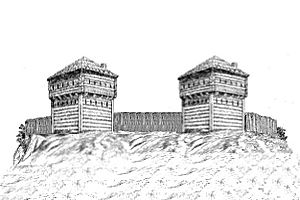Fort Denonville facts for kids
Quick facts for kids Fort Denonville |
|
|---|---|
| Niagara River | |
 |
|
| Site information | |
| Controlled by | New France |
| Site history | |
| Built | 1687 |
| In use | Abandoned |
Fort Denonville was a French fort built in 1687. It was located where Fort Niagara stands today. This fort replaced an older one called Fort Conti, which had burned down in 1679.
Contents
Building the Fort
Fort Denonville was built at the mouth of the Niagara River, right where it meets Lake Ontario. In the summer of 1687, the Governor of New France, Jacques-René de Brisay de Denonville, Marquis de Denonville, led a military trip. His goal was to make peace with the Iroquois people.
As the summer ended, the Governor wanted to keep a French presence in the area. So, he moved his army to this spot. They built a fort and named it after him.
What the Fort Looked Like
The fort had eight wooden buildings. It was surrounded by a strong wooden fence called a stockade. About one hundred soldiers stayed there. Captain Pierre de Troyes, Chevalier de Troyes was in charge. After building the fort, the Governor and most of his soldiers went back to Montreal for the winter.
The Difficult Winter
The Seneca, a group within the Iroquois, were upset about Governor Denonville's actions. They surrounded the fort. This meant the soldiers inside could not leave to find food or get fresh air.
During this time, many soldiers got sick. Eighty-nine of them died from scurvy, other diseases, and not enough food.
Help Arrives
On Good Friday in 1688, a group of French soldiers came to help. They found only twelve survivors inside the fort. The chaplain with the relief force was a Jesuit priest named Pierre Millet. He put up a cross and held a special church service. This was to give thanks that anyone had survived.
Abandoning the Fort
The fort was given new soldiers. But in September 1688, the French decided to leave. They took down the wooden fence. They did not stay there again during winter until 1726. That's when "The House of Peace," now known as the French Castle, and Fort Niagara were built on the same spot.

